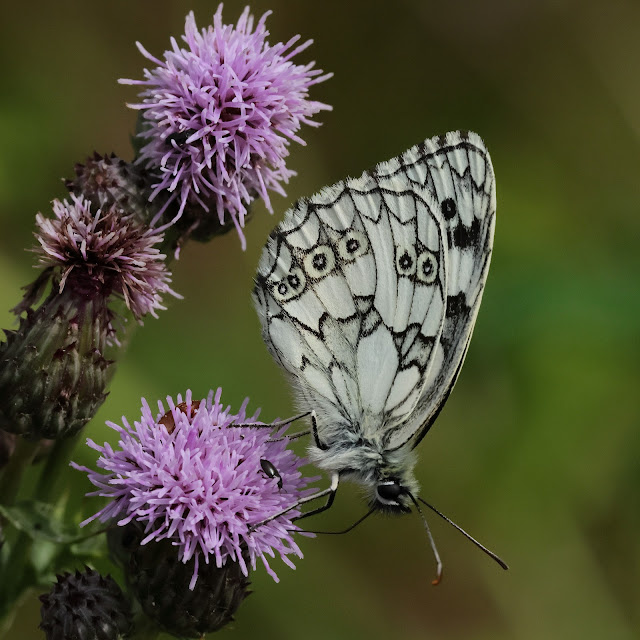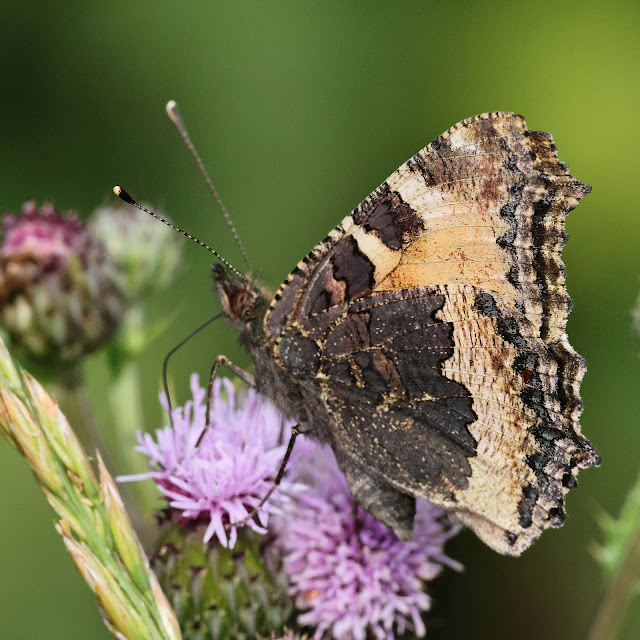Amphibians and Reptiles
Smooth Newt -
have been seen fairly regularly throughout the month in three different ponds
in LA.
Common Frog
- spotted on two occasions in a pond in Lewis Cres and again later in the month
in a damper part of the garden and under a pot. Early in the month four
tadpoles were spotted along with a froglet in one of the LA ponds. No toads
have been reported in which is unusual.
Birds
A total of 55 species from 640 reports this month,
from twelve reporters. A Nuthatch was heard in Lagden’s Grove, and also
in a LA garden, and a Little Egret was spotted along the river by the
recreation ground.
House Martin
were well reported throughout the month, with 5-6 seen around Mortlock Gardens,
and on GP. Whilst 12 Swift were seen around LA church, sightings have
generally been of 2-5 around Lewis Cres and Hall Farm, with only one occupied nest
at the latter site this year. Small groups of recently fledged Swallow
were seen on Cutting Rd and along the ORC.
Groups of young Blue Tit, Great Tit and Goldfinch
were reported, and a Blackbird with two young, and a Starling
with one young were seen in Lewis Cres. On GP lake, a Little Grebe was
seen feeding three well-grown juveniles, and three well-grown young Mandarin
Duck were seen there, as well as a female Mallard with ducklings (see
blog). A Great Crested Grebe, Moorhen, Grey Heron and
Pied Wagtail were all also seen on GP, with the latter species also being
spotted on North Rd with fledged young.
Blackcap and
Chiffchaff continued to be regularly heard along the ORC, the LSA, in
Sluice Wood and in a number of gardens. A Whitethroat was regularly
heard along the ORC, and both Reed Warbler and Reed Bunting were
occasionally heard in the GP reedbed - an indication that all these species continue
to hold nesting territories at these sites. Yellowhammer, Linnet,
Corn Bunting and Skylark were also heard along the ORC (see
blog).
A Great Spotted Woodpecker was spotted at
several sightings, and Green Woodpecker returned to several gardens this
month. A Mistle Thrush visited a North Rd garden and was also seen on
GP, whilst a Song Thrush was spotted and heard at several sites heard
and was seen gathering food. 1-2 Jay were also seen several times,
particularly around Cambridge Rd.
One or two Buzzard were regularly seen, and a Red
Kite was heard calling over Lewis Cres and was also seen at several sites.
A Kestrel was spotted around Cambridge Rd and Lewis Cres, and a Tawny
Owl was heard calling at dawn around Hall Farm.
Butterflies and other Insects
June brought 172 insect reports, a much larger number
than received in May. The number of butterfly reports was 139, comprising 18
species. Odonata reports were lower but did include 9 species, whereas only a
single species of damselfly had been seen before June this year.
Butterflies: Five
species were seen this month which had not been reported so far in 2025. These
summer species were Meadow Brown, Marbled White, Ringlet
and the three skipper species seen in the Abingtons; Large Skipper, Small
Skipper and Essex Skipper.
The most commonly seen was the Meadow Brown (19
reports from mid-June onwards), which was also the most reported of all the
butterfly species, beating Brimstone for the first time this year! Marbled
White was reported 8 times, initially on Granta Park on 15th (see
blog) but from several locations from 20th onwards. There was a single
report of a Ringlet on the ORC on 30th June.
Small/Essex Skipper (10 reports) were also seen from the middle of the month, with Essex
Skipper positively identified in three reports from the ORC and Lewis
Crescent. The only way to reliably distinguish them is the colour of the
underside of the tips of the antennae: black in Essex Skipper, orange in
Small Skipper. A Large Skipper was seen on the ORC on 20th June (see
blog).
Most butterfly species were reported in greater
numbers in June, compared to earlier in the year with one exception being Holly
Blue (single report) having been spotted 16 times in May.
Odonata: After
just a single species seen during May, the Large Red Damselfly, nine
species were spotted in June (in 17 reports). Large Red Damselfly
continued to be reported from several locations. Banded Demoiselle were
seen on 15th June by the river Granta on Granta Park and towards the end of the
month at the river near the Millennium Bridge. Blue-tailed Damselfly, Common
Blue Damselfly and Red-eyed Damselfly were also reported from Granta
Park (see
blog) and Azure Damselfly from a garden in Church Lane, LA.
Four dragonfly species were seen: Broad-bodied
Chaser (3 reports from different locations), Scarce Chaser and Southern
Hawker on Granta Park and Common Darter in a Lewis Cres garden, as
well as near the Millennium Bridge.
Other Species:
Bee species White-tailed Bumblebee, Buff-tailed Bumblebee and Red-tailed
Bumblebee continued to be seen regularly and Tawny Mining Bee was
reported in a garden in Church Lane. Hummingbird Hawkmoth were spotted
on flowers in two gardens and Scarlet Tiger Moth also had two reports,
and Solomon Seal Sawfly larvae were reported from High St LA (see
blog), as well as a Bush Cricket and several Rose Chafer
Beetle on Lewis Cres (see
blog). Interestingly on 29th June, a very warm windless day, at least seven
separate colonies of Black Ant were seen flying at the same time in a
garden in Lewis Cres.
Flora and Fungi
Good number
of Bee
Orchid were seen on
GP (see
blog), as
well as a Pyramidal Orchid, Kidney Vetch and Flag (see
blog). Unusually, a Pyramidal Orchid was
also seen along the ORC, along with Knapweed Broomrape and Goat’s Beard (see
blog), and where the flora diversity is good this year.
Field Poppy reported around Sluice
Wood (see
blog), with Field Scabious, Greater Knapweed and Ragwort seen
along the PRV (see
blog).
Mammals
Badger –
evidence in the strawberry bed in Lewis Cres; it ate all the strawberries on
1st and 6th.
Bats – Several
seen regularly throughout the month, probably Pipistrelles and maybe
some Serotine, in a Cambridge Rd garden and also in a Bourn Bridge Rd
garden. A large bat, probably a Natterer,
was seen in a Bourn Bridge Rd garden on 5th.
Fallow Deer
– two were seen on ORC on 20th.
Fox – one
was seen in Sluice Wood on 1st, one was seen in a Cambridge Rd garden on 22nd
and one appeared in a Bourn Bridge Rd garden on 30th.
Muntjac – one
was seen in a Cambridge Rd garden on 2nd, 15th, and 22nd,one was seen on the
path between High St and Chalky Rd on 8th, and one on ORC on 9th.
Weather
A very dry month with 32mm of rain when the average is
about 50mm and most of the rain fell in the first week of June (25.5mm). The
highest temperature was 35.2°C on the 31st along with several days with the
temperatures over 26°C! The lowest temperature was 7.3°C on the 9th. Winds were
generally from a south westerly to westerly direction.
NatureWatch events
The River Sampling
group met on 23rd May, see blog for results, and the pleasant evening walk around Granta
Park on 13th June was well attended (see blog). Our next trips will be to Trumpington Meadows on 16th
July, and to Fleam Dyke on 26th July. The full programme for the year can be viewed
on the ANW blog here, 2025 Programme Link.
Many thanks to all those who contributed their sightings this month.
Peter Brunning, Tricia Cullimore, Roger Dufresne, David & Gaynor Farrant, Janet Gerrard, Emma Jones, Carole McCrae, Len Mead, Andy & Polly Merryweather, Mary Miles, Joan Nevin, Gill Smith, Suzan Stewart, Maggie Turner, Derek Turnidge, John Webb,
Abbreviations: GA - Great
Abington, LA – Little Abington, LSA – Land Settlement Association, GP – Granta
Park, ORC – Old Railway Cutting, AbPkFm – Abington Park Farm.

































